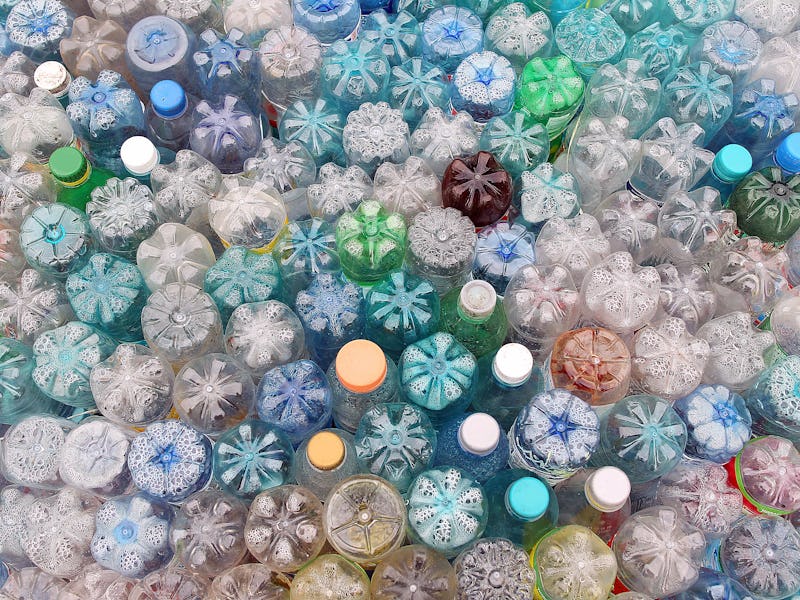A waterlogged bacteria and ancient enzyme could solve plastics' biggest problem
Scientists have discovered a hidden, important side-gig for a 3.2 billion-year-old class of enzymes.

New research has uncovered the secret side-gig of a 3.2 billion-year-old class of enzymes, called nitrogenase.
Scientists long believed that the primary function of these enzymes was to convert nitrogen into ammonia, an essential process that makes Earth habitable. But the new research describes a use for this enzyme that could help create more eco-friendly plastic production.
The enzymes are present in large quantities in a type of soil-dwelling bacteria, called Rhodospirillum rubrum. When exposed to oxygen-depleted environments, which nitrogenase thrives in, these bacteria reveal a previously unknown biological pathway, allowing it to transform sulfur into ethylene.
Ethylene is a natural gas used in the production of everyday plastics, like disposable grocery bags.
Together, the new observations may offer a safer way to create plastics without fossil fuels. They could also help farmers better understand how an abundance of ethylene may be harming their crops.
"We thought, well, that's weird."
Organisms burping out ethylene is something scientists have been actively studying for some time, but Justin North, a research scientist at Ohio State and first author of the new study, says that these previously identified biological pathways to ethylene had a bit of an explosive problem.
"For about a decade, researchers have studied the biological production of ethylene through a different mechanism that occurs in oxygenated environments," North tells Inverse. "There is a technical hurdle to scaling up that process as ethylene and oxygen mixed at industrial scales could be explosive."
Because this newly discovered pathway in bacteria is anaerobic, meaning it doesn't require oxygen, North says it may be possible to scale something like this without the risk of explosions.
The study was published Thursday in the journal Science.
Understanding how these microbes create ethylene can not only offer a more natural solution for plastic production but also help farmers mitigate crop losses.
How does it work — Unaware of their scientific import, these bacteria are simply generating the proteins they need for survival. In drier, more oxygenated soil conditions there may be more sulfur available to produce methionine, an amino acid necessary for building proteins. But in waterlogged soil, the availability of sulfur becomes much lower. The bacteria appear to solve this problem by turning to a handy survival skill: scavenging sulfur from the surrounding cellular waste instead.
As they did so, the bacteria appeared to burp out high levels of methane and ethylene as a byproduct.
"We know these bacteria are producing hydrogen and consuming carbon dioxide," North says.
"But, lo and behold, they were making copious amounts of ethylene gas. And we thought, well, that's weird."
Using mass spectroscopy, a technique that can look at the mass, structure, and composition of molecules, North and his colleagues discovered the ethylene-producing bacteria samples were chock-full of the ancient enzyme, nitrogenase. These enzymes date back over three billion years, and originally thrived at a time before needing oxygen for biological processes was all the rage.
As the enzyme's name would suggest, researchers previously believed this class of enzymes' sole purpose was to transform nitrogen into ammonia — a necessary process for supporting life on Earth — but Robert Hettich, one of the study's co-authors, says that sometimes long-held thinking can be misleading.
"Sometimes the naming or annotation of a gene or gene family can be misleading," Hettich tells Inverse. "In fact, the gene might have a secondary function, a night job so to speak, or it might actually be doing something completely different... [T]he data are the data."
Future impact — In addition to potentially offering a new path for scientists to harness natural ethylene gas for the production of plastics instead of relying on fossil fuels, the scientists say the discovery may also help farmers better manage their crops and understand how excess ethylene could be damaging them.
While ethylene in moderate amounts can be good for plant growth, excess ethylene (e.g. which this pathway might cause during flooding) can be damaging.
More research still has to be done to learn more about this pathway and how scalable it is, but this study opens an exciting new path of inquiry, the researchers say.
Abstract: Bacterial production of gaseous hydrocarbons such as ethylene and methane affects soil environments and atmospheric climate. We demonstrate that biogenic methane and ethylene from terrestrial and freshwater bacteria are directly produced by a previously unknown methionine biosynthesis pathway. This pathway, present in numerous species, uses a nitrogenase-like reductase that is distinct from known nitrogenases and nitrogenase-like reductases and specifically functions in C–S bond breakage to reduce ubiquitous and appreciable volatile organic sulfur compounds such as dimethyl sulfide and (2-methylthio)ethanol. Liberated methanethiol serves as the immediate precursor to methionine, while ethylene or methane is released into the environment. Anaerobic ethylene production by this pathway apparently explains the long-standing observation of ethylene accumulation in oxygen-depleted soils. Methane production reveals an additional bacterial pathway distinct from archaeal methanogenesis.
This article was originally published on